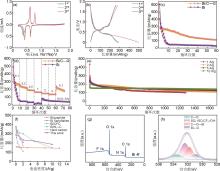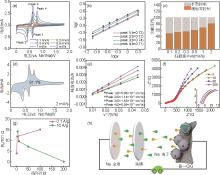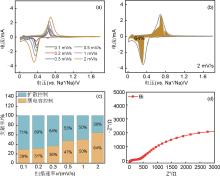Energy Storage Science and Technology ›› 2024, Vol. 13 ›› Issue (6): 1775-1785.doi: 10.19799/j.cnki.2095-4239.2024.0002
• Energy Storage Materials and Devices • Previous Articles Next Articles
Dan LI1,2( ), Tie MA2, Hanhao LIU1, Li GUO2
), Tie MA2, Hanhao LIU1, Li GUO2
Received:2024-01-02
Revised:2024-01-17
Online:2024-06-28
Published:2024-06-26
Contact:
Dan LI
E-mail:lidan@nuc.edu.cn
CLC Number:
Dan LI, Tie MA, Hanhao LIU, Li GUO. Carbon-coated nano-bismuth as high-rate sodium anode material[J]. Energy Storage Science and Technology, 2024, 13(6): 1775-1785.

Fig. 5
(a) The first three CV curves of the Bi-C/G electrode at a scanning rate of 0.1 mV/s with a voltage window of 0.2—1.8 V, (b) The first three charge and discharge curves of the Bi-C/G electrode at 0.1 A/g, Cyclic (c) and rate (d) performance of Bi and Bi-C/G electrodes at 0.1 A/g, (e) Ultra-long cycle performance of Bi-C/G electrodes at 1 A/g, 2 A/g, 5 A/g, 10 A/g, respectively, (f) Comparison of rate properties with the bismuth-based composite anodes and hard carbon anode. XPS spectra(g) and O 1s spectra (h) of Bi electrode after two cycles at 0.1 A/g"


Fig. 6
CV curves (a) obtained by Bi-C/G electrode at different scanning rates (0.1—2 mV/s), and linear relationship (b) between scanning rate log(v) and peak current log(i) corresponding to different REDOX peaks, (c) Comparison of capacity contributions of diffusion control and pseudocapacitance control in Bi-C/G, (d) CV controlled by pseudocapacitance and original CV curve with a scan rate of 2 mV/s, (e) The linear relationship between the peak current i and the square root of the scanning rate v1/2 and the calculated diffusion coefficient of sodium ions. The AC impedance (f) of the Bi-C/G at 10 A/g, and the variation rule between the fitted Rct value and the cycle order (g), (h) Schematic diagram of the electrochemical reaction of a sodium ion battery and the transport path of sodium ions"


Fig. 7
(a) CV curves obtained by Bi electrode at different scanning rates (0.1—2 mV/s), (b) CV curve controlled by pseudocapacitance and original CV curve with a scan rate of 2 mV/s, (c) Comparison of capacity contributions of diffusion control and pseudocapacitance control in Bi, (d) The AC impedance of the Bi electrode cycled at 10 A/g for once"

| 1 | CHEN J, ADIT G, LI L, et al. Optimization strategies toward functional sodium-ion batteries[J]. Energy & Environmental Materials, 2023, 6(4): e12633. |
| 2 | SADA K, DARGA J, MANTHIRAM A. Challenges and prospects of sodium-ion and potassium-ion batteries for mass production[J]. Advanced Energy Materials, 2023, 13(39): 2302321. |
| 3 | LI L, ZHENG Y, ZHANG S L, et al. Recent progress on sodium ion batteries: Potential high-performance anodes[J]. Energy & Environmental Science, 2018, 11(9): 2310-2340. |
| 4 | DELMAS C. Sodium and sodium-ion batteries: 50 years of research[J]. Advanced Energy Materials, 2018, 8(17): 1703137. |
| 5 | CHEN L, FIORE M, WANG J E, et al. Readiness level of sodium-ion battery technology: A materials review[J]. Advanced Sustainable Systems, 2018, 2(3): 1700153. |
| 6 | KIM H, KIM H, DING Z, et al. Recent progress in electrode materials for sodium-ion batteries [J]. Advanced Energy Materials, 2016, 6(19): 1600943. |
| 7 | SUN Y, GUO S H, ZHOU H S. Exploration of advanced electrode materials for rechargeable sodium-ion batteries[J]. Advanced Energy Materials, 2019, 9(23): 1800212. |
| 8 | QIAO S Y, ZHOU Q W, MA M, et al. Advanced anode materials for rechargeable sodium-ion batteries[J]. ACS Nano, 2023, 17(12): 11220-11252. |
| 9 | HOU H S, QIU X Q, WEI W F, et al. Carbon anode materials for advanced sodium-ion batteries[J]. Advanced Energy Materials, 2017, 7(24): 1602898. |
| 10 | LI Y F, KONG M H, HU J P, et al. Carbon-microcuboid-supported phosphorus-coordinated single atomic copper with ultrahigh content and its abnormal modification to Na storage behaviors[J]. Advanced Energy Materials, 2020, 10(19): 2000400. |
| 11 | YOU Y, MANTHIRAM A. Progress in high-voltage cathode materials for rechargeable sodium-ion batteries[J]. Advanced Energy Materials, 2018, 8(2): 1701785. |
| 12 | LI D, ZHOU J S, CHEN X H, et al. Amorphous Fe2O3/graphene composite nanosheets with enhanced electrochemical performance for sodium-ion battery[J]. ACS Applied Materials & Interfaces, 2016, 8(45): 30899-30907. |
| 13 | LAO M M, ZHANG Y, LUO W B, et al. Alloy-based anode materials toward advanced sodium-ion batteries[J]. Advanced Materials, 2017, 29(48): 1700622. |
| 14 | LI D, LIU H H, LIU Z J, et al. Copper oxide nitrogen-rich porous carbon network boosts high-performance supercapacitors[J]. Metals, 2023, 13(5): 981. |
| 15 | LIU H H, LI D, LIU H L, et al. CoSe2 nanoparticles anchored on porous carbon network structure for efficient Na-ion storage[J]. Journal of Colloid and Interface Science, 2023, 634: 864-873. |
| 16 | LIU H H, LI D, LIU H L, et al. Devisable three-dimensional Cu2Se nanoarrays boosts high rate Na-ion storage[J]. Applied Surface Science, 2023, 612: 155725. |
| 17 | LI D, LIU H L, LIU H H, et al. A NiCoSex/CG heterostructure with strong interfacial interaction showing rapid diffusion kinetics as a flexible anode for high-rate sodium storage[J]. Dalton Transactions, 2023, 52(16): 5192-5201. |
| 18 | LI D, ZHOU J S, CHEN X H, et al. Achieving ultrafast and stable Na-ion storage in FeSe2 nanorods/graphene anodes by controlling the surface oxide[J]. ACS Applied Materials & Interfaces, 2018, 10(26): 22841-22850. |
| 19 | WEI S W, LI W, MA Z Z, et al. Novel bismuth nanoflowers encapsulated in N-doped carbon frameworks as superb composite anodes for high-performance sodium-ion batteries[J]. Small, 2023, 19(46): e2304265. |
| 20 | UD DIN M A, LI C, ZHANG L H, et al. Recent progress and challenges on the bismuth-based anode for sodium-ion batteries and potassium-ion batteries[J]. Materials Today Physics, 2021, 21: 100486. |
| 21 | ZHANG X S, QIU X Q, LIN J X, et al. Structure and interface engineering of ultrahigh-rate 3D bismuth anodes for sodium-ion batteries[J]. Small, 2023, 19(35): e2302071. |
| 22 | FU L J, TANG K, SONG K P, et al. Nitrogen doped porous carbon fibres as anode materials for sodium ion batteries with excellent rate performance[J]. Nanoscale, 2014, 6(3): 1384-1389. |
| 23 | CHEN L, HE X J, CHEN H M, et al. N-doped carbon encapsulating Bi nanoparticles derived from metal-organic frameworks for high-performance sodium-ion batteries[J]. Journal of Materials Chemistry A, 2021, 9(38): 22048-22055. |
| 24 | LI D, HU J P, WANG C, et al. Metal-organic framework-induced edge-riched growth of layered Bi2Se3 towards ultrafast Na-ion storage[J]. Journal of Power Sources, 2023, 555: 232387. |
| 25 | LI D, ZHOU J S, CHEN X H, et al. Graphene-loaded Bi2Se3: A conversion-alloying-type anode material for ultrafast gravimetric and volumetric Na storage[J]. ACS Applied Materials & Interfaces, 2018, 10(36): 30379-30387. |
| 26 | LIU H L, LI D, LIU H H, et al. Binary self-assembly of ordered Bi4Se3/Bi2O2Se lamellar architecture embedded into CNTs@graphene as a binder-free electrode for superb Na-ion storage[J]. Journal of Colloid and Interface Science, 2022, 620: 168-178. |
| 27 | XUE P, WANG N N, FANG Z W, et al. Rayleigh-instability-induced bismuth nanorod@nitrogen-doped carbon nanotubes as a long cycling and high rate anode for sodium-ion batteries[J]. Nano Letters, 2019, 19(3): 1998-2004. |
| 28 | CHEN J, FAN X L, JI X, et al. Intercalation of Bi nanoparticles into graphite results in an ultra-fast and ultra-stable anode material for sodium-ion batteries[J]. Energy & Environmental Science, 2018, 11(5): 1218-1225. |
| 29 | LIU S N, LUO Z G, GUO J H, et al. Bismuth nanosheets grown on carbon fiber cloth as advanced binder-free anode for sodium-ion batteries[J]. Electrochemistry Communications, 2017, 81: 10-13. |
| 30 | WANG L B, WANG C C, LI F J, et al. In situ synthesis of Bi nanoflakes on Ni foam for sodium-ion batteries[J]. Chemical Communications, 2017, 54(1): 38-41. |
| 31 | HOU B H, WANG Y Y, NING Q L, et al. Self-supporting, flexible, additive-free, and scalable hard carbon paper self-interwoven by 1D microbelts: Superb room/low-temperature sodium storage and working mechanism[J]. Advanced Materials, 2019, 31(40): e1903125. |
| 32 | WANG L B, VOSKANYAN A A, CHAN K Y, et al. Combustion synthesized porous bismuth/N-doped carbon nanocomposite for reversible sodiation in a sodium-ion battery[J]. ACS Applied Energy Materials, 2020, 3(1): 565-572. |
| 33 | WANG J, POLLEUX J, LIM J, et al. Pseudocapacitive contributions to electrochemical energy storage in TiO2 (anatase) nanoparticles[J]. The Journal of Physical Chemistry C, 2007, 111(40): 14925-14931. |
| 34 | XIAO Y H, ZHAO X B, WANG X Z, et al. A nanosheet array of Cu2Se intercalation compound with expanded interlayer space for sodium ion storage[J]. Advanced Energy Materials, 2020, 10(25): 2000666. |
| 35 | ZHANG K, HU Z, LIU X, et al. FeSe2 microspheres as a high-performance anode material for Na-ion batteries[J]. Advanced Materials, 2015, 27(21): 3305-3309. |
| 36 | CAI D, LIU B K, ZHU D H, et al. Ultrafine Co3Se4 nanoparticles in nitrogen-doped 3D carbon matrix for high-stable and long-cycle-life lithium sulfur batteries[J]. Advanced Energy Materials, 2020, 10(19): 1904273. |
| 37 | FAN L L, LI X F, YAN B, et al. Controlled SnO2 crystallinity effectively dominating sodium storage performance[J]. Advanced Energy Materials, 2016, 6(10): 1502057. |
| 38 | YOU Y, YAO H R, XIN S, et al. Subzero-temperature cathode for a sodium-ion battery[J]. Advanced Materials, 2016, 28(33): 7243-7248. |
| 39 | JIAN Z L, XING Z Y, BOMMIER C, et al. Hard carbon microspheres: Potassium-ion anode versus sodium-ion anode[J]. Advanced Energy Materials, 2016, 6(3): 1501874. |
| 40 | LI Z, ZHANG J T, LU Y, et al. A pyrolyzed polyacrylonitrile/selenium disulfide composite cathode with remarkable lithium and sodium storage performances[J]. Science Advances, 2018, 4(6): eaat1687. |
| [1] | Yingjian CHEN, Shang WU, Yuancheng CAO, Baoshuai DU, Zhenxing WANG, Zhongwen OUYANG, Shun TANG. Application of magnetic separation in the recycling of cathode and anode materials from spent lithium batteries [J]. Energy Storage Science and Technology, 2025, 14(5): 1918-1927. |
| [2] | Qiangfu SUN, Guanjun CEN, Ronghan QIAO, Jing ZHU, Junfeng HAO, Xinxin ZHANG, Mengyu TIAN, Zhou JIN, Yuanjie ZHAN, Yong YAN, Liubin BEN, Hailong YU, Yanyan LIU, Hong ZHOU, Xuejie HUANG. Reviews of selected 100 recent papers for lithium batteries (Feb. 1, 2025 to March 31, 2025) [J]. Energy Storage Science and Technology, 2025, 14(5): 1727-1747. |
| [3] | Fuxing SHAN, Haibo HUO, Zheng ZHANG, Binbin JIAN, Jun CHEN. Step-charging strategy and optimization of sodium-ion batteries [J]. Energy Storage Science and Technology, 2025, 14(4): 1668-1678. |
| [4] | Bohua WEN, Haijun MENG, Yonglong CHEN, Xiaohui LI, Jiayan LUO, Lin LIN, Lan ZHANG. Research progress on high specific-energy solid-state lithium-sulfur batteries [J]. Energy Storage Science and Technology, 2025, 14(4): 1424-1444. |
| [5] | Zhao CHEN, Qinqin LIANG, Yuting LI, Fei XIE, Bin TANG, Jianxin LI, Yaxiang LU, Aibing CHEN, Yongsheng HU. Recent progress of tin-based alloy-type anode materials in Na-ion batteries [J]. Energy Storage Science and Technology, 2025, 14(3): 883-897. |
| [6] | Gongxun LU, Huadong YUAN, Jianmin LUO, Yao WANG, Yujing LIU, Peng SHI, Shihui ZOU, Guangmin ZHOU, Xinyong TAO, Jianwei NAI. Surface pre-treatment strategies for lithium metal: Advancement and perspective [J]. Energy Storage Science and Technology, 2025, 14(3): 947-964. |
| [7] | Liping ZHOU, Deqing ZHOU, Fenghua ZHENG, Qichang PAN, Sijiang HU, Yongjie JIANG, Hongqiang WANG, Qingyu LI. Preparation and application of Si@void@C composite anode materials for lithium-ion batteries [J]. Energy Storage Science and Technology, 2025, 14(3): 1115-1122. |
| [8] | Xinxin ZHANG, Guanjun CEN, Ronghan QIAO, Jing ZHU, Junfeng HAO, Qiangfu SUN, Mengyu TIAN, Zhou JIN, Yuanjie ZHAN, Yong YAN, Liubin BEN, Hailong YU, Yanyan LIU, Hong ZHOU, Xuejie HUANG. Reviews of 100 selected recent papers on lithium batteries (December 1, 2024 to January 31, 2025) [J]. Energy Storage Science and Technology, 2025, 14(3): 1310-1330. |
| [9] | Xinyuan JIA, Xianfu ZHANG, Long ZHANG. Research progress on micromodification and macrodesign of Zn powder anodes in aqueous Zn metal batteries [J]. Energy Storage Science and Technology, 2025, 14(3): 913-929. |
| [10] | Yi LIANG, Tao WEI, Guangda YIN, Dequan HUANG. Design of a lithiophilic Ag-3D-Cu electrode and its electrochemical performance [J]. Energy Storage Science and Technology, 2025, 14(2): 515-524. |
| [11] | Meiling PAN, Nannan SUN, Zhichao ZHAO. Theoretical study of two-dimensional VC2 as an anode material for sodium-ion batteries [J]. Energy Storage Science and Technology, 2025, 14(2): 497-504. |
| [12] | Junfeng HAO, Guanjun CEN, Ronghan QIAO, Jing ZHU, Qiangfu SUN, Xinxin ZHANG, Mengyu TIAN, Zhou JIN, Yuanjie ZHAN, Yong YAN, Liubin BEN, Hailong YU, Yanyan LIU, Hong ZHOU, Xuejie HUANG. Reviews of selected 100 recent papers for lithium batteries (Oct. 1, 2024 to Nov. 30, 2024) [J]. Energy Storage Science and Technology, 2025, 14(1): 388-405. |
| [13] | Xinxin ZHANG, Guanjun CEN, Ronghan QIAO, Jing ZHU, Junfeng HAO, Qiangfu SUN, Mengyu TIAN, Zhou JIN, Yuanjie ZHAN, Yong YAN, Liubin BEN, Hailong YU, Yanyan LIU, Hong ZHOU, Xueji HUANG. In-depth review of 100 pioneering studies on lithium batteries: Key innovations from June 1, 2024 to July 31, 2024 [J]. Energy Storage Science and Technology, 2024, 13(9): 3226-3244. |
| [14] | Yanyan KONG, Xiong ZHANG, Yabin AN, Chen LI, Xianzhong SUN, Kai WANG, Yanwei MA. Recent advances in preparation of MOF-derived porous carbon-based materials and their applications in anodes of lithium-ion capacitors [J]. Energy Storage Science and Technology, 2024, 13(8): 2665-2678. |
| [15] | Zhiyong WANG, Junyao CAI, Yingqi SHE, Shulin ZHONG, Kanghua PAN. Surface-modification of graphite with N-heterocyclic conducting polymers as high performance anodes for Li-ion batteries [J]. Energy Storage Science and Technology, 2024, 13(8): 2511-2518. |
| Viewed | ||||||
|
Full text |
|
|||||
|
Abstract |
|
|||||
